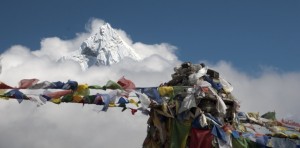Editor's Note: The following article first appeared in the blog of Mosaic Adventure, an ATTA member specializing in trips to the Himalaya. Opinions expressed are those of the operator, not the ATTA.
On 25th April 2015 a powerful earthquake of magnitude 7.9 struck the central region of Nepal in the Gorkha district just north of the main highway between Kathmandu and Pokhara. The earthquake was followed by a number of severe aftershocks that were felt as far away as India, Bangladesh, and Tibet. As a result, there were more than 8000 people found dead and thousands more injured, not to mention the wholesale destruction of buildings throughout the whole of the country. It also laid waste to some of the nation’s historic monuments including centuries-old palaces and temples listed as UNESCO World Heritage Sites.
The earthquake triggered an avalanche on Mount Everest in the famous trekking regions of Manaslu and Langtang. Langtang village itself bore the brunt of the catastrophe, with the entire village completely buried by the avalanche as it descended from the Langtang slopes thousands of feet above.
However, while the earthquake has shaken the land of Nepal, it has been unable to shake the courage, strength, and spirit of its people. What you see now is not death and despair but a fiercely resilient population going about the task of regrouping and rebuilding in the wake of this massive catastrophe. The Kathmandu Valley is alive and kicking and striving to get back on its feet. Relief is slowly reaching the earthquake-affected villages, with local government and various NGO’s and INGO’s joining forces in an effort to bring life back to normal. Heritage sites like Swayambhu, the three Durbar Squares, and many other ancient settlements and monuments will not be fully reconstructed for some time, but the locals together with local authorities have at least initiated plans for their renovation. In time, all of these magnificent structures will be repaired and brought back to life.
“Our greatest accomplishment is not in never falling, but in rising every time we fall.”– Vince Lombardi
Despite damage to historical and cultural monuments, Nepal is still able to welcome tourists with open arms. Roads and air transport links remain intact across the country; the majority of hotels and restaurants are already back in operation; and apart from the regions of Manaslu and Langtang, most trekking areas have escaped widespread damage. Tourism is one of the mainstays of the Nepalese economy, and Nepal will certainly need the income that tourism brings as it attempts to recover from this disaster.
Have you ever travelled to Nepal? Start making plans! October and November are Nepal’s peak season for tourism, and are of course the best time of year to come and visit. Trekking in Langtang region has, sadly, been highly impacted, so it will probably not be until the end of the September that tourism resumes here in earnest. The people of these areas have lost everything as a result of the earthquake; the best way to support them is by helping to restore their former way of life. Most of the people of the area depend highly on the income generated from tourists visiting the region; it is only really this income that will help the people recover from the tragedy.
The majestic Himalayan Mountains and lush countryside still await the more intrepid visitor, while the people of the region busily rebuild so they can welcome visitors with the friendliness and generosity that the Nepali people are famous for. Travelling to these areas will help the local economy enormously, and will function as a primary source of ongoing sustainable aid. And you need have no fear for your own safety – Nepalese architecture from now on will tend more towards stronger and safer structures.
Other than the highly affected areas of Manaslu and Langtang, trekking in most other regions can be undertaken at any time; Manaslu will start by end of September and probably Langtang too. Pokhara is very safe, and still captivates with its magnificent mountain views and serene lakes. Chitwan and Bardia also escaped widespread damage, and are thus ready to showcase their abundance of natural life. The birthplace of the Buddha, Lumbini, did not incur much damage and is thankfully all set to welcome visitors back to its sacred soil.
So what are you waiting for? Come and visit the magnificent and bustling country of Nepal, and support her as she attempts to stand proudly on her feet once again. Walk the beautiful trails in the shadow of the most magnificent mountains on earth as you help the Nepalese people reset their course on the path to prosperity. And consider this: how good you will feel knowing that you were among the first to show the rest of the world that Nepal is once again a safe place to visit and explore; that there is nothing to fear and everything to be gained by witnessing first-hand the indomitable spirit of its people as they set about constructing a new identity, a new architecture, a new legacy on top of the still living and breathing vestiges of the old identity, the old architecture, and the old legacy. Nepal is now embarking upon the most fascinating period in all of its ancient history, and you could be right there to see it happen.
So come on: start thinking RIGHT NOW about the most important adventure you’ll ever undertake. Start planning your trip. Trust us. We promise you it’ll be the greatest thing you’ll ever do in your life.

